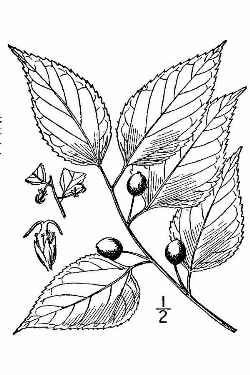
Britton, N.L., and A. Brown. 1913. Illustrated flora of the northern states and Canada. Vol. 3: 20. Courtesy of Kentucky Native Plant Society. Scanned by Omnitek Inc.
Sunset®: All zones
USDA: 2-9
Heat Tolerance: Light shade better when juvenile
Sun Exposure: Full sun
Origin: Eastern USA, northern Mexico
Growth Habits: Deciduous tree, grows rapidly up to 70 feet tall (20 m), by 50 feet spread (15 m) or more
Watering Needs: Moderate water
Propagation: Generally seeds, sometimes cuttings
Propagation: Seed or occasionally cutting, grafting/budding
- by cuttings, in autumn.
- by chip grafts, in late summer.
- by seeds, in spring. Germinates at 70-85 degrees F. The seeds can be harvested in autumn. The seeds need stratify 40F 2-3mo.. The usual germination temperature is 70-85 degrees F.

Robert H. Mohlenbrock. USDA SCS. 1989. Midwest wetland flora: Field office illustrated guide to plant species. Midwest National Technical Center, Lincoln
Host for the Snout butterfly (Libytheana carinenta) caterpillars.
Blooming Habits:
Greenish-yellow flowers in April and May
Fruiting Habits:
The fruit is a fleshy, globose drupe, 0.2 to 0,4 inch in diameter (5-10 mm), it is green most of the summer, turning red when ripe in September and October. The flesh is thin and quite dry but edible and sweet, with a large pit.
Desert-Tropicals is dedicated to provide gardening advice, gardening ideas, and information about flower of all kind for landscape and collections.We try to check carefully the identification of the plants on the illustrations as well as the other information from the page, but occasionally errors do occur. if you notice anything that needs to be changed please contact us.Thanks.
© 1998-2020 Philippe Faucon, All Rights Reserved.